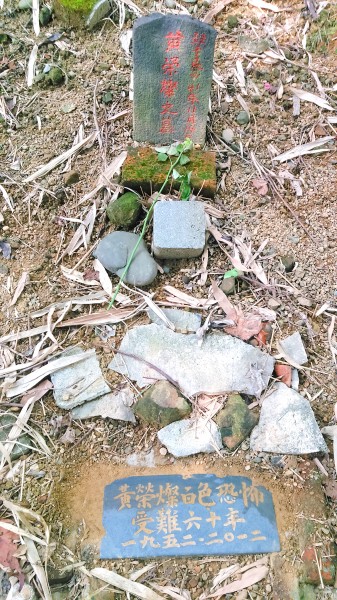《TAIPEI TIMES 焦點》Terror era victims’ families decry neglected memorial

The neglected grave of artist Huang Jung-tsan, who created the famous printed engraving The Horrifying Inspection, is pictured in a memorial park for the victims of political persecution in Taipei on Saturday. Photo: Chen Yen-chun, Taipei Times
A GRAVE MATTER: Relatives of hundreds of people killed during the start of the White Terror era say that a Taipei park honoring the dead has not been properly maintained
By Chen Yen-chun and Lin Shu-hui / Staff reporters
The families of nearly 200 people killed in the beginning of the White Terror era have complained that a memorial park in Taipei’s Liuzhangli (六張犁) commemorating the victims of political persecution has fallen into disrepair due to government negligence, an act of neglect they branded as being disrespectful of the dead.
The Park Commemorating Victims of Political Persecution during the Martial Law Period’s (戒嚴時期政治受難者紀念公園) First Cemetery on Chongde Street in the city’s Xinyi District (信義) is covered with leaves and weeds, and strewn with cement bricks. Some of its tombstones have been toppled over, and trash and empty bottles lie strewn everywhere.
The memorial was established in 2003 to honor nearly 200 victims of political persecution between 1949 and 1953. Each tombstone is no bigger than a brick, on which the name of the victim and the date of their death are inscribed.
One of the victims’ family members who complained about the park’s upkeep, a woman surnamed Huang (黃), said a cemetery manager has been put in charge of the facility’s maintenance, but due to its size and a lack of staff, the task of maintaining the park was next to impossible.
She expressed hope that the government would be more attentive to the issue and properly take on the responsibility for the park’s maintenance.
Taipei Mortuary Services Office Director Wu Kun-hong (吳坤宏) said the office outsourced the maintenance of the graveyard to a cleaning company at the beginning of the year, but the contract was terminated due to the company’s financial instability. The government will find a new contractor to take over the task, he added.
Lin Chuan-kai (林傳凱), a researcher who has worked for years on the history of the White Terror era and its victims, said the public sector has taken only nominal care of the memorial park since its establishment, with most of the cleaning being done by the victims’ families and related groups.
However, the topography and relatively soft soil of the First Cemetery site make it necessary for the authorities to carry out any restoration efforts, Lin said.
He suggested that the government better publicize information about the people interred at the cemetery who lost their lives in the White Terror era and produce a visitor’s guide to the monuments to help the public better understand this period in the nation’s history.
Among the many renowned figures honored at the park is Huang Jung-tsan (黃榮燦), who created the now famous printed engraving The Horrifying Inspection (恐怖的檢查) in the aftermath of the 228 Incident.
The 228 Incident refers to the brutal military crackdown launched by the then-Chinese Nationalist Party (KMT) regime against civilian demonstrations in 1947, following an incident in Taipei on Feb. 27.
The event marked the beginning of the White Terror era, in which tens of thousands of Taiwanese were killed, went missing or were imprisoned as the government sought to stamp out dissent and forbade any discussion of the Incident.
新聞來源:TAIPEI TIMES

Huang Jung-tsan’s printed engraving The Horrifying Inspection, created in 1947, soon after the 228 Massacre, is pictured in an undated photograph. Photo: Chen Yen-chun, Taipei Times

















